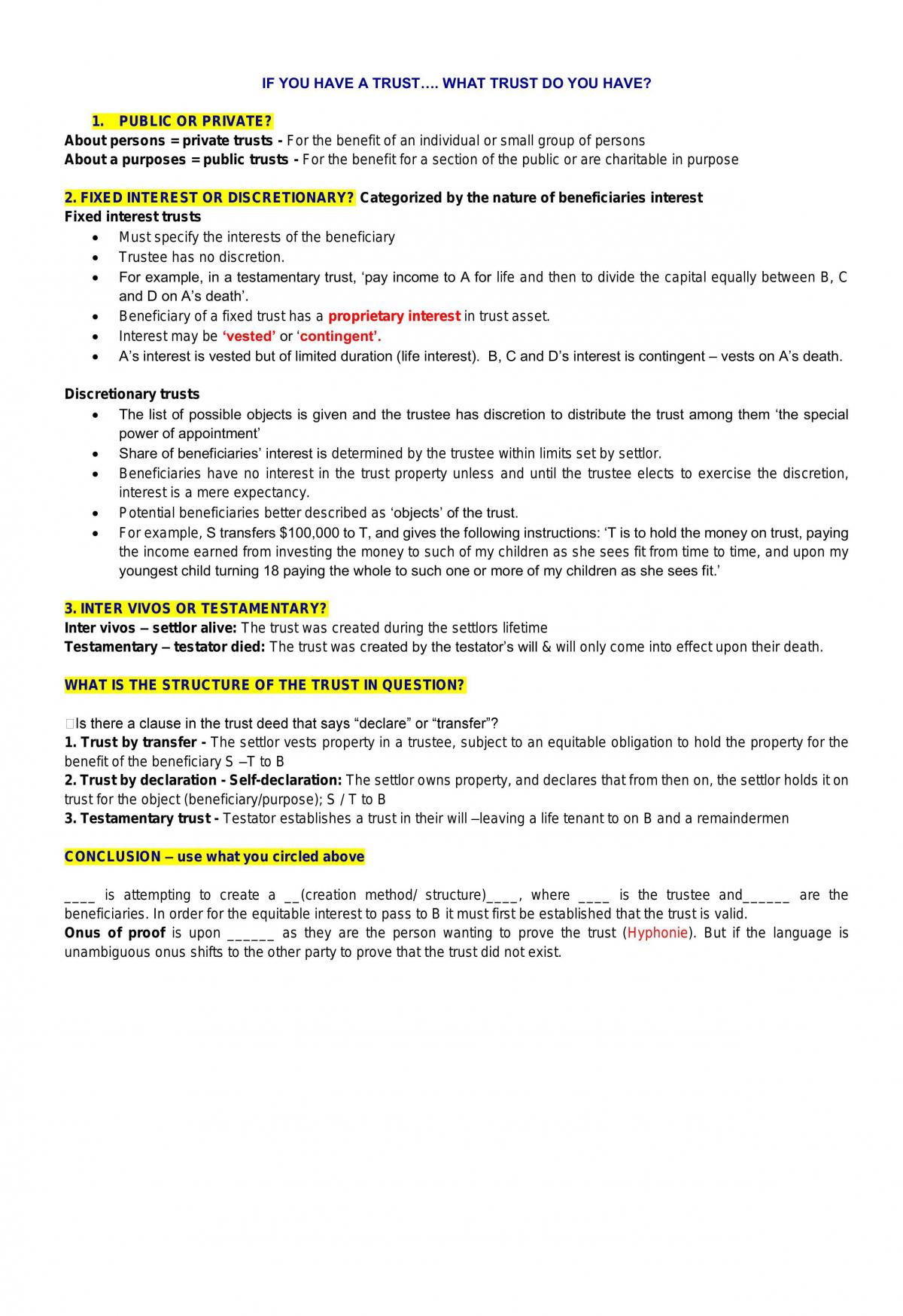Find
Search for over 200,000 study notes and past assignments!
Swap
Download study resources by swapping your own or buying Exchange Credits.
Study
Study from your library anywhere, anytime.
1 Found helpful • 40 Pages • Complete Study Notes • Year: Pre-2021
Topics covered: Certainty of intention, Certainty of object Test Fixed Trust, Discretionary Trust, Certainty of subject matter, Trust must be constituted, Present legal property, Equitable Assignment rules, Statutory Formalities, Charitable Trusts, Quitclose Trusts, Doctrine of Cy-pres, Trusties Duties and Defences, Trusties Fiduciary Duties, Defences and limitations of liability, Right to reimbursement from beneficiaries, Rights of Beneficiaries, Remedies for breach of trust. There must have been an intention to create/declare a trust (Korda). This is an objective test (Byrnes), and subjective intentions are irrelevant (Twinsectra per Lord Millett). ____, the settlor must have indicated by words or conduct that s/he intended to create a trust (Byrnes). In this case ___will argue intention was indicated by _____(Formal written document – trust deed?/ Informal written words?/ Oral?) 1. PUBLIC OR PRIVATE? About persons = private trusts - For the benefit of an individual or small group of persons About a purposes = public trusts - For the benefit for a section of the public or are charitable in purpose 2. FIXED INTEREST OR DISCRETIONARY? Categorized by the nature of beneficiaries interest Fixed interest trusts • Must specify the interests of the beneficiary • Trustee has no discretion. • For example, in a testamentary trust, ‘pay income to A for life and then to divide the capital equally between B, C and D on A’s death’. • Beneficiary of a fixed trust has a proprietary interest in trust asset. • Interest may be ‘vested’ or ‘contingent’. • A’s interest is vested but of limited duration (life interest). B, C and D’s interest is contingent – vests on A’s death. Discretionary trusts • The list of possible objects is given and the trustee has discretion to distribute the trust among them ‘the special power of appointment’ • Share of beneficiaries’ interest is determined by the trustee within limits set by settlor. • Beneficiaries have no interest in the trust property unless and until the trustee elects to exercise the discretion, interest is a mere expectancy. • Potential beneficiaries better described as ‘objects’ of the trust. • For example, S transfers $100,000 to T, and gives the following instructions: ‘T is to hold the money on trust, paying the income earned from investing the money to such of my children as she sees fit from time to time, and upon my youngest child turning 18 paying the whole to such one or more of my children as she sees fit.’ 3. INTER VIVOS OR TESTAMENTARY? Inter vivos – settlor alive: The trust was created during the settlors lifetime Testamentary – testator died: The trust was created by the testator’s will & will only come into effect upon their death. WHAT IS THE STRUCTURE OF THE TRUST IN QUESTION? Is there a clause in the trust deed that says “declare” or “transfer”? 1. Trust by transfer - The settlor vests property in a trustee, subject to an equitable obligation to hold the property for the benefit of the beneficiary S –T to B 2. Trust by declaration - Self-declaration: The settlor owns property, and declares that from then on, the settlor holds it on trust for the object (beneficiary/purpose); S / T to B 3. Testamentary trust - Testator establishes a trust in their will –leaving a life tenant to on B and a remaindermen CONCLUSION – use what you circled above ____ is attempting to create a __(creation method/ structure)____, where ____ is the trustee and______ are the beneficiaries. In order for the equitable interest to pass to B it must first be established that the trust is valid. Onus of proof is upon ______ as they are the person wanting to prove the trust (Hyphonie). But if the language is unambiguous onus shifts to the other party to prove that the trust did not exist.
This document is 50 Exchange Credits
More about this document:
|
|
This document has been hand checkedEvery document on Thinkswap has been carefully hand checked to make sure it's correctly described and categorised. No more browsing through piles of irrelevant study resources. |
|
|
This is a Complete Set of Study NotesComplete Study Notes typically cover at least half a semester’s content or several topics in greater depth. They are typically greater than 20 pages in length and go into more detail when covering topics. |
|
|
What are Exchange Credits?Exchange Credits represent the worth of each document on Thinkswap. In exchange for uploading documents you will receive Exchange Credits. These credits can then be used to download other documents for free. |
|
|
Satisfaction GuaranteeWe want you to be satisfied with your learning, that’s why all documents on Thinkswap are covered by our Satisfaction Guarantee. If a document is not of an acceptable quality or the document was incorrectly described or categorised, we will provide a full refund of Exchange Credits so that you can get another document. For more information please read Thinkswap's Satisfaction Guarantee. |

Studying with Academic Integrity
Studying from past student work is an amazing way to learn and research, however you must always act with academic integrity.
This document is the prior work of another student. Thinkswap has partnered with Turnitin to ensure students cannot copy directly from our resources. Understand how to responsibly use this work by visiting ‘Using Thinkswap resources correctly’.
Browse Monash Subjects




